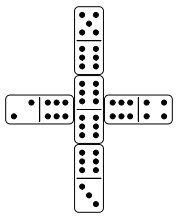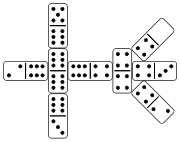.gif)
Chicken Foot (domino game)
Encyclopedia
Chicken foot, also known as Chicken dominoes, Chickie dominoes and Chickie, is a dominoes
game of the "Trains" family, similar to Mexican Train
. Chicken Foot is played in rounds, one round for each double domino in the set. The game is normally played by 2 to 8 players using any of the common sets (double-six, double-nine, double-twelve, double-fifteen or double-eighteen).

In the first round only, everyone draws a single domino from the boneyard. The player drawing the highest value begins the round and everyone returns their drawn domino to the boneyard. The starting player must play a matching domino (one with an end of the same value as the double) from their hand on one of the four sides of the double, with the matching end against the double. The next player plays another matching domino on a remaining side, and this continues until all four sides are filled. If a player cannot play because they do not have a matching domino, then the player must draw one domino from the bone yard. If that domino does not match, their turn passes to the next player. No other plays can be made until all four sides of the double are filled.
Once all four sides are filled, the player to the left of the last person to fill the 6 can play any domino in their hand that matches an exposed end of a played domino. If a player is unable to match any exposed dominoes, they must draw one domino from the bone pile and either play it if possible or pass. If the boneyard has been emptied, any player who cannot play simply passes. If no player can play or draw, the round ends.

to one side, and three more dominoes on the opposite side, the middle being perpendicular and the other two at 45 degrees to perpendicular. Any player who does not have a domino matching the played double must draw a domino from the bone pile and then play it if it matches or pass. Once three matching dominoes are played to finish the chicken foot, the next player may play a domino on any matching endpoint, including any of the three branches of the new chicken foot. No one may play on any other domino until the chicken foot is complete.
At the end of each round, each player sums up the spots on the dominoes in their hand, which becomes their score for that hand and is added to their running total. Alternately, when all players still have dominoes remaining, the score can be "curved" by reducing each player's score by the lowest score (the player with the lowest count thus gets no points as if they had emptied their hand). The score keeper tallies up all scores, crosses out the double that lead the round and the next round begins. In each subsequent round, the highest double drawn that has not yet been used to start a round starts the next round. When a round for each double has been played, the game is over and player with the lowest score wins.
Dominoes
Dominoes generally refers to the collective gaming pieces making up a domino set or to the subcategory of tile games played with domino pieces. In the area of mathematical tilings and polyominoes, the word domino often refers to any rectangle formed from joining two congruent squares edge to edge...
game of the "Trains" family, similar to Mexican Train
Mexican Train
Mexican Train, also known as simply Trains, is a game played with dominoes. The object of the game is for a player to play all the dominoes from his or her hand onto one or more chains, or "trains", emanating from a central hub or "station". The game's most popular name comes from a special...
. Chicken Foot is played in rounds, one round for each double domino in the set. The game is normally played by 2 to 8 players using any of the common sets (double-six, double-nine, double-twelve, double-fifteen or double-eighteen).
Objective
The object of the game is to have the lowest score at the end of the last round. For each round, the object is for the player to empty their hand of dominoes by playing them on the board.Setup
The dominoes are first turned face down and shuffled. Then, each player picks seven dominoes to form their hand. With more than four players, the game requires an extended set. The number of dominoes drawn can be increased when fewer players are using a larger set (for instance, four players using a double-twelve set can draw 15 dominoes). Any remaining dominoes are placed to the side, forming the boneyard.
The First Round
The round begins with the highest double being placed in the center of the layout to start the game (using a double-six set, this would be the double 6). (In each proceeding round, the next lowest double is found and placed as the starting point: 6, 5, 4, etc. until the last round using the double blank.)In the first round only, everyone draws a single domino from the boneyard. The player drawing the highest value begins the round and everyone returns their drawn domino to the boneyard. The starting player must play a matching domino (one with an end of the same value as the double) from their hand on one of the four sides of the double, with the matching end against the double. The next player plays another matching domino on a remaining side, and this continues until all four sides are filled. If a player cannot play because they do not have a matching domino, then the player must draw one domino from the bone yard. If that domino does not match, their turn passes to the next player. No other plays can be made until all four sides of the double are filled.
Once all four sides are filled, the player to the left of the last person to fill the 6 can play any domino in their hand that matches an exposed end of a played domino. If a player is unable to match any exposed dominoes, they must draw one domino from the bone pile and either play it if possible or pass. If the boneyard has been emptied, any player who cannot play simply passes. If no player can play or draw, the round ends.

Chicken Foot
Any time a player plays a matching double on an endpoint, the player calls "Chickie (Number)" to indicate they have started a new "chicken foot". For example, if a player played a double 4 on the end of a 6/4 domino they would lay it long side against the end with the 4 and call "Chickie Fours". No other dominoes can be played until three more 4's are played against the other side of the double 4. The three dominoes played against the double 4 are played on the long side opposite the side originally played. The end result will look like a chicken foot (hence the name of the game) with the double having one domino laid perpendicularPerpendicular
In geometry, two lines or planes are considered perpendicular to each other if they form congruent adjacent angles . The term may be used as a noun or adjective...
to one side, and three more dominoes on the opposite side, the middle being perpendicular and the other two at 45 degrees to perpendicular. Any player who does not have a domino matching the played double must draw a domino from the bone pile and then play it if it matches or pass. Once three matching dominoes are played to finish the chicken foot, the next player may play a domino on any matching endpoint, including any of the three branches of the new chicken foot. No one may play on any other domino until the chicken foot is complete.
Ending a round
A round is over when either one player plays the last domino in their hand or no players can make a legal play. The latter situation can occur if someone plays a double that no longer has three remaining free dominoes to play on it and is common with smaller sets once the boneyard is exhausted.At the end of each round, each player sums up the spots on the dominoes in their hand, which becomes their score for that hand and is added to their running total. Alternately, when all players still have dominoes remaining, the score can be "curved" by reducing each player's score by the lowest score (the player with the lowest count thus gets no points as if they had emptied their hand). The score keeper tallies up all scores, crosses out the double that lead the round and the next round begins. In each subsequent round, the highest double drawn that has not yet been used to start a round starts the next round. When a round for each double has been played, the game is over and player with the lowest score wins.
Strategy
- Since the object of the game is to have the lowest score, it is in each player's best interest to get rid of their high value dominoes, while at the same time preventing opponents from playing theirs.
- To this end, one strategy is to try to keep high value exposed ends covered which prevents opponents from chickie-ing them.
- Another strategy is to hoard low-value dominoes and try to use up a particular number for which a player also possesses the double. Once a player knows that there are no longer three free dominoes to complete a chicken foot, that player controls when the round ends by playing the chickie. This is especially advantageous for a player who also has a matching domino they can play as their last domino.
- It is a good idea to keep the double-blank domino if it is dealt or drawn, as it gives no value to the player holding it.
- Like pokerPokerPoker is a family of card games that share betting rules and usually hand rankings. Poker games differ in how the cards are dealt, how hands may be formed, whether the high or low hand wins the pot in a showdown , limits on bet sizes, and how many rounds of betting are allowed.In most modern poker...
, watching for "tells" can allow a player to guess which other players have high counts, and thus make plays that block those players from being able to play high-value tiles.

